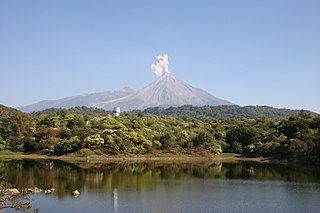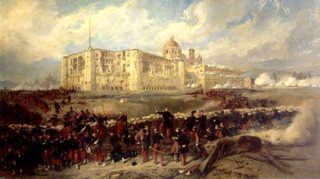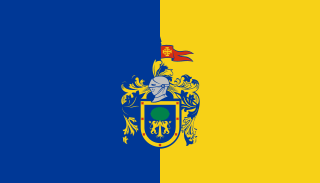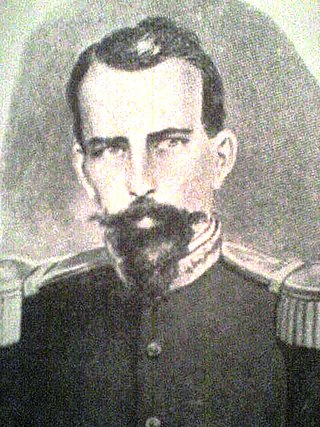
Colima, located in central−western Mexico, is the capital of the state of the same name and the seat of the municipality of the same name, which is the easternmost and third largest municipality in Colima behind Tecomán and Manzanillo. It is located near the Colima volcano, which divides the state from Jalisco. Colima is the state's second largest municipality by population after Manzanillo.

Colima, officially the Free and Sovereign State of Colima, is among the 31 states that make up the 32 Federal Entities of Mexico. It shares its name with its capital and main city, Colima.

Miguel Gregorio de la Luz Atenógenes Miramón y Tarelo, known as Miguel Miramón, was a Mexican conservative general who disputed the Mexican presidency with Benito Juarez at the age of twenty seven during the Reform War, serving between February 1859 and December 1860. He was the first Mexican president to be born after the Mexican War of Independence.

The second French intervention in Mexico, also known as the Second Franco-Mexican War (1861–1867), was a military invasion of the Republic of Mexico by the French Empire of Napoleon III, purportedly to force the collection of Mexican debts in conjunction with Great Britain and Spain. Mexican conservatives supported the invasion, since they had been defeated by the liberal government of Benito Juárez in a three-year civil war. Defeated on the battlefield, conservatives sought the aid of France to effect regime change and establish a monarchy in Mexico, a plan that meshed with Napoleon III's plans to re-establish the presence of the French Empire in the Americas. Although the French invasion displaced Juárez's Republican government from the Mexican capital and the monarchy of Archduke Maximilian was established, the Second Mexican Empire collapsed within a few years. Material aid from the United States, whose four-year civil war ended in 1865, invigorated the Republican fight against the regime of Maximilian, and the 1866 decision of Napoleon III to withdraw military support for Maximilian's regime accelerated the monarchy's collapse.

The Ecuadorian–Colombian War was a series of armed conflicts waged between the current republics of Colombia and Ecuador between 1862 and 1863.

Jalisco, officially the Free and Sovereign State of Jalisco, is one of the 31 states which, along with Mexico City, comprise the 32 Federal Entities of Mexico. It is located in western Mexico and is bordered by six states, Nayarit, Zacatecas, Aguascalientes, Guanajuato, Michoacán, and Colima. Jalisco is divided into 125 municipalities, and its capital and largest city is Guadalajara.
Alfonso Michel was a Mexican painter, contemporary with the Mexican muralism movement, but whose artistry made him a forerunner to the Generación de la Ruptura that followed.

The Battle of Llanos de Santa Juana took place during the War of Mexican Independence on 12 July 1811 in the area around Cuauhtémoc, Colima known as Llanos de Santa Juana. The battle was fought between the royalist forces loyal to the Spanish crown and the Mexican rebels fighting for independence from the Spanish Empire. The Mexican insurgents were commanded by General José Calixto Martínez y Moreno and the Spanish by Colonel Manuel del Río. The battle resulted in a victory for the Spanish royalists.

Salvador Cienfuegos Zepeda is a retired Mexican Army officer. He served as the Secretary of National Defense in the government of President Enrique Peña Nieto from 2012 to 2018.
This is a list of events that happened in 2014 in Mexico. The article also lists the most important political leaders during the year at both federal and state levels.
This is a list of events that happened in 2015 in Mexico. The article also lists the most important political leaders during the year at both federal and state levels.

José Ignacio Peralta Sánchez is a Mexican politician from the Institutional Revolutionary Party who served as the Governor of Colima until 2021.
The Battle of San Joaquín in the War of Reform took place on 26 December 1858 in the municipality of Cuauhtémoc, between elements of the liberal army, under General Santos Degollado, and elements of the conservative army, commanded by General Miguel Miramón.

Nemesio Rubén Oseguera Cervantes, commonly referred to by his alias El Mencho, is a Mexican drug lord and leader of the Jalisco New Generation Cartel (CJNG), an organized crime group based in Jalisco. He is the most wanted person in Mexico and one of the most wanted in the U.S. The US government and the Mexican government are offering rewards of US$15 million and MXN$30 million, respectively, for information leading to his arrest.

The Revolution of 1904 was a civic-military revolt led by Aparicio Saravia against the government of José Batlle y Ordóñez in Uruguay. It was the last military conflict between Blancos and Colorados.

José Antonio Abundio de Jesús Rosales Flores (1822-1865) was a Mexican Brigadier General during the Reform War and the Second French intervention in Mexico. Also known as the Hero of San Pedro for his victory at the Battle of San Pedro, Rosales was the Governor of Sinaloa after overthrowing Jesús García Morales from October 5, 1864, to March 9, 1865, before being killed at the Battle of Álamos.

Antonio Rojas, nicknamed El Matacuras, was a Mexican Guerrilla who participated in the Reform War and the Second French intervention in Mexico. He fought independently in both wars due to his differing and controversial strategies and tactics throughout both wars until being killed at Mascota, Jalisco.

Ángel Martínez, also known as the Machetero or El Machete was a Mexican general during the 19th-century. He had a prominent military career during the Second French intervention in Mexico, being a key commander across the state of Colima. He was also a major figure of the Yaqui Wars, notably ordering the execution of Cajemé.
Bernardo Méndez de Figueroa nicknamed "El Pavo" was a Nicaraguan military figure most notable for reestablishing military absolutism in Nicaragua in 1837 during the presidency of José Núñez.
José Francisco Gallardo Rodríguez often known as General Gallardo was a Mexican military general and academic who ran for the governorship of Colima twice.












